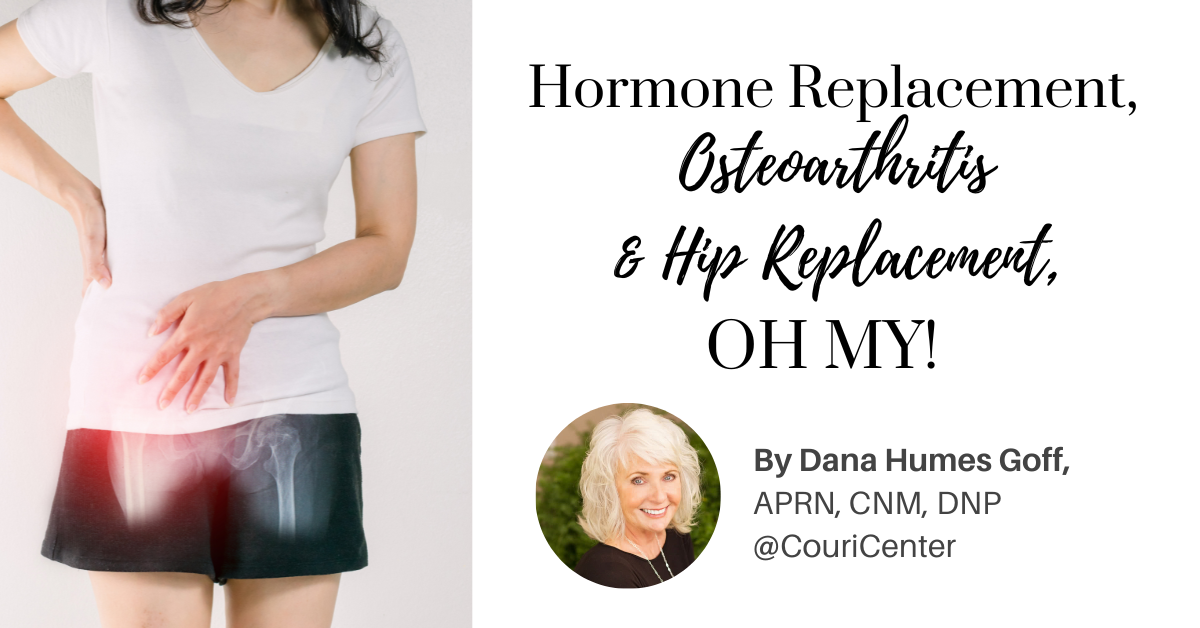
This month’s article is on a more personal level for me than the articles I share in the Couri Center Newsletter. I’ve recently returned to the office from medical leave after a hip replacement in August 2022. Incidentally, I had a previous hip replacement on the alternate hip in 2014 by the same surgeon, with osteoarthritis being the cause for both.
After an uneventful surgery and postoperative recovery, I noticed that, although I was eight years older, I recovered much more quickly than I did with my first hip replacement.
Certainly, awareness and experience contributed to some degree; however, I began to reflect on what other differences might have played a role in my recovery, and I began to do some research.
For the record, I have been dedicated to working out and weightlifting for the past 3 years, a hobby I picked up during the pandemic, so I felt stronger and in better shape than I did in 2014.
I realized the other variance was that I had begun estrogen and testosterone replacement in 2017 in the form of bio-identical hormone pellets at The Couri Center, and I feel certain this was a major contributing factor to my quick recovery.
Research and clinical observations have identified an increase in osteoarthritis during, or soon after menopause occurs. Estradiol, the most potent form of estrogen, is a known protective factor in the prevention of osteoarthritis. Research has repeatedly identified a significant link between estrogen deficiency and joint pain, decreased cartilage, and inflammation post-menopause.
While it is well established that estrogen replacement benefits aging joints, testosterone can also be. Many believe that testosterone only affects men, but it plays a pivotal role in the female body chemistry. If a testosterone level is sub-optimal, individuals will likely experience more difficulty healing. Studies have also indicated higher serum testosterone was associated with increased cartilage growth in joints.
A recent Swedish study focused on the effects of testosterone on chondrocytes, which are the cells responsible for re-growing cartilage. This research concluded that testosterone promotes the differentiation of chondrocytes and increases collagen production. This study, along with an Australian study, found higher serum concentrations of testosterone were associated with a decreased risk for total knee and hip replacement caused by osteoarthritis.
For years now, doctors and researchers have been puzzled by the fact that women who underwent hip replacement surgery were 30% more likely than men to need repeat surgery within the first 3 years postoperatively. The initial focus was the possibility that the artificial implant itself was faulty, resulting in many negligent malpractice claims. Dr. Art Sedrakyan, a co-author of a 2013 study and an associate professor of public health at Weill Cornell University, declared the higher rate of revision occurrence was possibly due to estrogen and/or testosterone deficiencies in menopause.
Expounding on Dr. Sedrakyan’s hypothesis, a 2014 British study in the Annals of Rheumatic Diseases found that hormone replacement therapy (HRT) offered significant promise in reducing the need for joint revision surgery. The study indicated that women who had used HRT for at least 6 months after their hip replacement were 38% less likely to need a repeat procedure than those who had not used HRT. These studies have encouraged some orthopedic surgeons, such as a Colorado orthopedic surgeon, Dr. Michael Janssen, at the Center for Spine and Orthopedics, to recommend bio-identical hormone pellets after spinal surgery to optimize recovery and reduce the need for revision.
The potential side effects and risks associated with HRT need to be considered as to whether the benefits of osteoarthritis prevention and joint replacement surgery outweigh those risks. Women should continue to look at HRT as part of their healthcare in general, not just for orthopedic benefits alone.
New patients are welcome! Schedule via our online patient portal or call 309-692-6838.
Dana Humes Goff, APRN, CNM, DNP
Sources
Inacio, C. A. (2013). Sex and the risk of hip implant failure: assessing total hip arthoplastyoutcomes in the United States. The Journal of the American Medical Association, 435-41.
Richmond, R. C. (2000). Functional estrogen recpetors in adult articular cartilege: estrogen repalcment therapy. Arthritis & Rheumatism: official Journal of American Colloege of Rherumatology, 2081-90.
Slidellmemorial.org. (2021). Reducing the Risk of Implant Failure: Hormone Replacement Therapy and Orthopedic Services. Slidell, Louisiana.
Steilen-Matias, D. H. (2022). Hormone Replacement therapy and osteoarthritis-degenerative joint disease. Fort Myers, Florida.
Andersson, A., Bernardi, A.I., Nurkkala-Karlsson, M., Stubelius, A., Grahnemo, L.,et al. (2016) Suppression of experimental arthritis and associated bone loss by a tissue-selective estrogen complex. Endocrinology. Mar;157(3):1013-20. doi: 10.1210/en.2015-1820.
Loeser, R.F., Goldring, S.R., Scanzello, C.R., Goldring, M. (2012). Osteoarthritis: A disease of the joint as an organ. Arthritis & Rheumatology, June, 64 (6), 1697-1707
